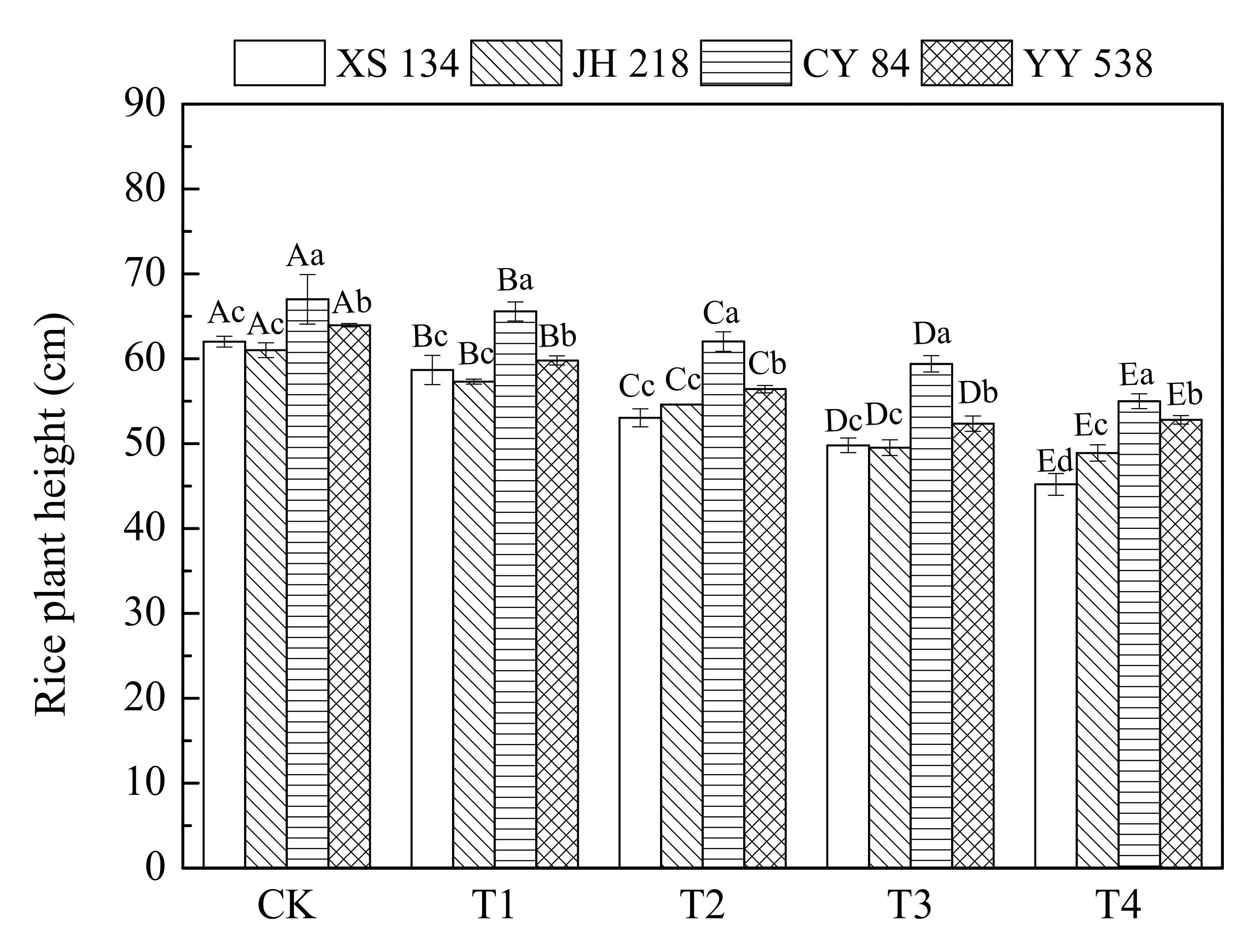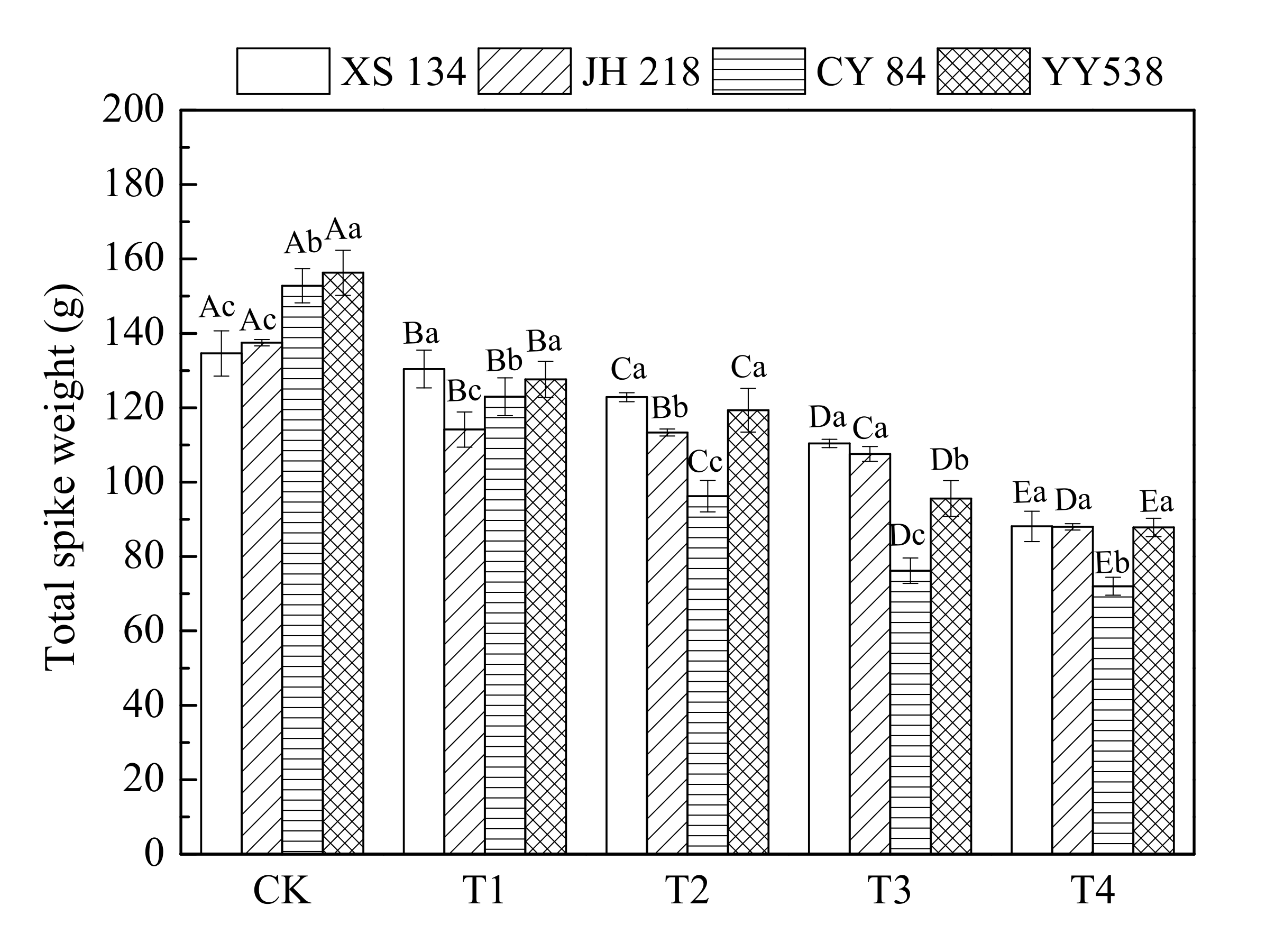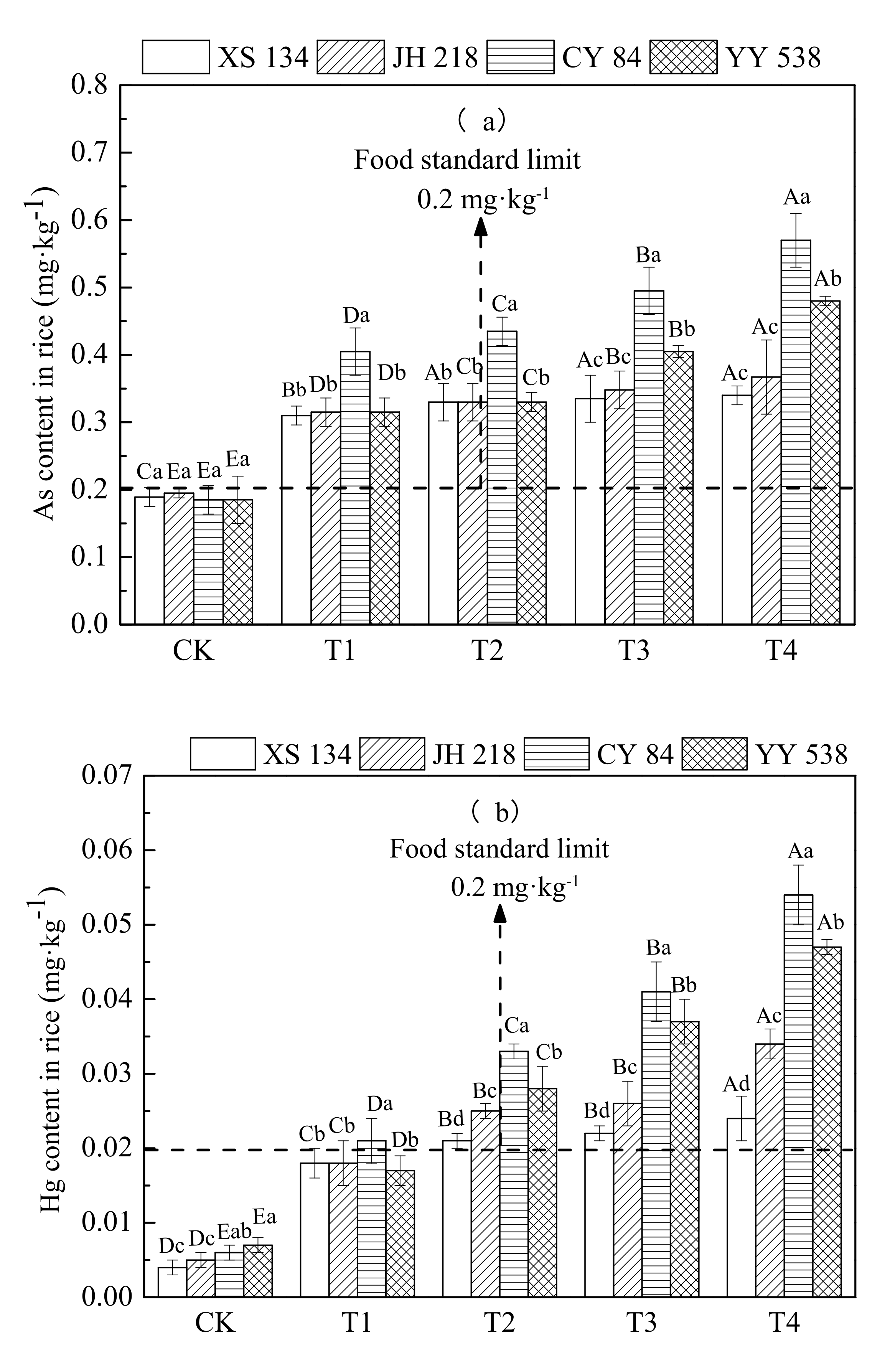As-Hg Compound Pollution: Rice Growth, Yield, and Environmental Safety Limits
Abstract
1. Introduction
2. Materials and Methods
2.1. Experimental Materials
2.2. Soil Treatment
2.3. Rice Planting Management and Sample Collection
2.4. Determination of As and Hg Content in Rice Samples
2.5. Ecological Risk Assessment to Calculate As and Hg Safety Limit Values
2.6. Estimation of As and Hg Safety Limits Based on Health Risk Assessment
2.7. Data Analysis and Methods
3. Results
3.1. Effects of PTEs on Rice Growth
3.2. Accumulation of As and Hg in Rice Grains
3.3. Ecological Risk of PTEs in Soil
3.4. Soil PTE Health Risk Limits
4. Discussion
4.1. Effect of As-Hg Complex Pollution on Rice Growth
4.2. Effects of As-Hg Complex Pollution on Absorption and Accumulation of PTEs by Rice
4.3. Soil As and Hg Safety Limits
5. Conclusions
Author Contributions
Funding
Acknowledgments
Conflicts of Interest
References
- Huang, J.; Hsu, S.; Wang, S. Effects of rice straw ash amendment on Cu solubility and distribution in flooded rice paddy soils. J. Hazard. Mater. 2011, 186, 1801–1807. [Google Scholar] [CrossRef] [PubMed]
- Li, Z.; Ma, Z.; Kuijp, T.J.; Yuan, Z.; Huang, L. A review of soil heavy metal pollution from mines in China: Pollution and health risk assessment. Sci. Total Environ. 2014, 468–469, 843–853. [Google Scholar] [CrossRef] [PubMed]
- Huang, Y.; Chen, G.; Xiong, L.; Huang, Y. Current situation of heavy metal pollution in farmland soil and phytoremediation application. Asian Agric. Res. 2016, 8, 22–24. [Google Scholar]
- Lu, Y.; Song, S.; Wang, R.; Liu, Z.; Meng, J.; Sweetman, A.J.; Jenkins, A.; Ferrier, R.C.; Li, H.; Luo, W.; et al. Impacts of soil and water pollution on food safety and health risks in China. Environ. Int. 2015, 77, 5–15. [Google Scholar] [CrossRef]
- Röhr, A.; Lüddecke, K.; Drusch, S.; Müller, M.J.; Alvensleben, R.V. Food quality and safety-consumer perception and public health concern. Food Control 2005, 16, 649–655. [Google Scholar] [CrossRef]
- Zhao, K.L.; Liu, X.M.; Xu, J.M.; Selim, H.M. Heavy metal contaminations in a soil-rice system: Identification of spatial dependence in relation to soil properties of paddy fields. J. Hazard. Mater. 2010, 181, 778–787. [Google Scholar] [CrossRef]
- Neza, F.; Domen, L. The two-phase leaching of Pb, Zn and Cd contaminated soil using EDTA and electrochemical treatment of the washing solution. Chemosphere 2008, 73, 1484–1491. [Google Scholar]
- Chen, Z.; Zhu, Y.G.; Liu, W.J.; Meharg, A.A. Direct evidence showing the effect of root surface iron plaque on arsenite and arsenate uptake into rice (Oryza sativa) roots. New Phytol. 2005, 165, 91–97. [Google Scholar] [CrossRef]
- Han, F.X.; Su, Y.; Monts, D.L.; Plodinec, M.J.; Banin, A.; Triplett, G.E. Assessment of global industrial-age anthropogenic arsenic contaminationt. Springer J. 2003, 90, 395–401. [Google Scholar]
- Bhattacharya, P.; Welch, A.H.; Stollenwerk, K.G.; McLaughlin, M.J.; Bundschuh, J.; Panaullah, G. Arsenic in the environment: Biology and chemistry. Sci. Total Environ. 2007, 379, 109–120. [Google Scholar] [CrossRef]
- Brammer, H. Mitigation of arsenic contamination in irrigated paddy soils in South and South-east Asia. Environ. Int. 2009, 35, 856–863. [Google Scholar] [CrossRef] [PubMed]
- Peng, X.Y.; Wang, M.Y.; Liu, F.J.; Ye, Z.H. Arsenic pollution in rice and its mechanism of arsenic uptake and metabolism. J. Ecol. 2010, 30, 4782–4791. [Google Scholar]
- Hakanson, L. An ecological risk index for aquatic pollution control: A sedimentological approach. Water Res. 1980, 14, 975–1001. [Google Scholar] [CrossRef]
- Luo, Y.M.; Teng, Y. Status of soil pollution degradation and countermeasures in China. Soils 2006, 18, 505–508. [Google Scholar]
- Román, R.; Fortún, C.; García López De Sá, M.E.; Almendros, G. Successful soil remediation and reforestation of a calcic regosol amended with composted urban waste. Arid Land Res. Manag. 2003, 17, 297–311. [Google Scholar] [CrossRef]
- Irem, S.; Islam, E.; Maathuis, F.J.M.; Niazi, N.K.; Li, T. Assessment of potential dietary toxicity and arsenic accumulation in two contrasting rice genotypes: Effect of soil amendments. Chemosphere 2019, 225, 104–114. [Google Scholar] [CrossRef]
- Du, X.P.; Kang, J.Q.; Lu, J.Y. Selection for low-Cd-accumulating cultivars of pakchoi (Brassica chinensis L.), effects of sulfur on Cd content, and quality characters under Cd stress. J. Agro Environ. Sci. 2018, 37, 1592–1601. [Google Scholar]
- Grant, C.A.; Clarke, J.M.; Duguid, S.; Chaney, R.L. Selection and breeding of plant cultivars to minimize cadmium accumulation. Sci. Total Environ. 2008, 390, 301–310. [Google Scholar] [CrossRef]
- Wang, L.M.; Wei, C.Y.; Yang, L.S. Arsenic accumulation and speciation in two rice varieties and related health risks. Acta Sci. Circumstantiae 2010, 30, 832–840. [Google Scholar]
- Fan, Z.L.; Ji, H.; Yang, F.; Wu, Q.; Zhang, W.J. Accumulation characteristics of Cd and Pb in rice grain and their security threshold values in paddy field under different soil types. Ecol. Environ. Sci. 2010, 19, 792–797. [Google Scholar]
- Ding, C.F.; Zhang, T.L.; Wang, X.X.; Zhou, F.; Yang, Y.R.; Huang, G.F. Prediction model for cadmium transfer from soil to carrot (Daucus carota L.) and its application to derive soil thresholds for food safety. J. Agric. Food Chem. 2013, 61, 10273–10282. [Google Scholar] [CrossRef] [PubMed]
- Li, J.R.; Xu, Y.M. Immobilization of Cd in paddy soil using moisture management and amendment. Environ. Sci. Pollut. Res. 2015, 22, 5580–5586. [Google Scholar] [CrossRef] [PubMed]
- Yin, J.; Li, H.; Lu, W. Difference of Cu accumulation and distribution in different rice varieties. Ecol. Environ. Sci. 2010, 19, 334–339. [Google Scholar]
- Thapa, S.; Ranjan, K.; Ramakrishnan, B.; Velmourougane, K.; Prasanna, R. Influence of fertilizers and rice cultivation methods on the abundance and diversity of phyllosphere microbiome. J. Basic Microbiol. 2017, 58, 172–186. [Google Scholar] [CrossRef]
- Fu, Y.; Li, F.; Guo, S. Cadmium pollution in soil and rice plants in Zhangyizhan Town of Zhangshi irrigation area of Shenyang. Chin. J. Ecol. 2017, 36, 1965–1972. [Google Scholar]
- Laender, F.D.; Schamphelaere, K.A.C.D.; Vanrolleghem, P.A.; Janssen, C.R. Is ecosystem structure the target of concern in ecological effect assessments? Water Res. 2008, 42, 2395–2402. [Google Scholar] [CrossRef]
- Zhang, P.Y.; Qin, M.Z.; Chen, L. Study on distribution characteristics and potential ecological risk of soil heavy metal in the Yellow River Beach Region in Kaifeng City. Environ. Sci. 2013, 34, 3654–3662. [Google Scholar]
- Pérez Chaca, M.V.; Vigliocco, A.; Reinoso, H.; Molina, A.; Abdala, G.; Zirulnik, F.; Pedranzani, H. Effects of cadmium stress on growth, anatomy and hormone contents in Glycine max (L.) Merr. Acta Physiol. Plant. 2014, 36, 2815–2826. [Google Scholar]
- Wan, Y.; Luo, S.L.; Chen, J.L.; Xiao, X.; Chen, L.; Zeng, G.M.; Liu, C.B.; He, Y.J. Effect of endophyte-infection on growth parameters and Cd-induced phytotoxicity of Cd-hyperaccumulator Solanum nigrum L. Chemosphere 2012, 89, 743–750. [Google Scholar] [CrossRef]
- Gautam, M.; Sengar, R.S.; Chaudhary, R.; Sengar, K.; Garg, S. Possible cause of inhibition of seed germination in two rice cultivars by heavy metal Pb2+ and Hg2+. Toxicol. Environ. Chem. 2010, 92, 1111–1119. [Google Scholar] [CrossRef]
- Fariduddin, Q.; Yusuf, M.; Hayat, S.; Ahmad, A. Effect of 28-homobrassinolide on antioxidant capacity and photosynthesis in Brassica juncea plants exposed to different levels of copper. Environ. Exp. Bot. 2009, 66, 418–424. [Google Scholar] [CrossRef]
- Ekmekçi, Y.; Tanyolac, D.; Ayhan, B. Effects of cadmium on antioxidant enzyme and photosynthetic activities in leaves of two maize cultivars. J. Plant Physiol. 2008, 165, 600–611. [Google Scholar] [CrossRef] [PubMed]
- Ahsan, N.; Lee, S.H.; Lee, D.G.; Lee, H.; Lee, S.W.; Bahk, J.D.; Lee, B.H. Physiological and protein profiles alternation of germinating rice seedlings exposed to acute cadmium toxicity. Comp. Study 2007, 330, 735–746. [Google Scholar] [CrossRef] [PubMed]
- Ahsan, N.; Lee, D.G.; Lee, S.H.; Kang, K.Y.; Lee, J.J.; Kim, P.J.; Lee, B.H. Excess copper induced physiological and proteomic changes in germinating rice seeds. Chemosphere 2007, 67, 1182–1193. [Google Scholar] [CrossRef]
- Sahu, G.K.; Upadhyay, S.; Sahoo, B.B. Mercury induced phytotoxicity and oxidative stress in wheat (Tritucum aestivum L.) plants. Physiol. Mol. Biol. Plants 2012, 18, 21–31. [Google Scholar] [CrossRef]
- Chen, Z.; Chen, M.; Jiang, M. Hydrogen sulphide alleviates mercury toxicity by sequestering it in roots or regulating reactive oxygen species production in rice seedlings. Plant Physiol. Biochem. 2017, 111, 179–192. [Google Scholar] [CrossRef]
- Chang, T.; Ye, L.L.; Chen, Y.S. Impact of high concentrations of heavy metal in agricultural soil on heavy metal accumulation and physiological characteristics of rice (Oryza sativa L.) in karst areas in Guangxi, China. J. Agro Environ. Sci. 2018, 37, 27–35. [Google Scholar]
- Nagajyoti, P.C.; Lee, K.D.; Sreekanth, T.V.M. Heavy metal, occurrence and toxicity for plants: A review. Environ. Chem. Lett. 2010, 8, 119–216. [Google Scholar] [CrossRef]
- Sun, Y.; Zhou, Q.; Wang, L.; Liu, W. Cadmium tolerance and accumulation characteristics of Bidens pilosa L. as a potential Cd-hyperaccumulator. J. Hazard. Mater. 2009, 161, 808–814. [Google Scholar] [CrossRef]
- Wei, S.; Zhou, Q. Screen of Chinese weed species for cadmium tolerance and accumulation characteristics. Int. J. Phytoremediat. 2008, 10, 584–597. [Google Scholar] [CrossRef]
- Kumarathilaka, P.; Seneweera, S.; Meharg, A.; Bundschuh, J. Arsenic accumulation in rice (Oryza sativa L.) is influenced by environment and genetic factors. Sci. Total Environ. 2018, 642, 485–496. [Google Scholar] [CrossRef] [PubMed]
- Shan, T.Y.; Liu, Q.X.; Yan, X.L. Cd and As absorption and transport characteristics of rice in a paddy field co-contaminated by Cd and As. J. Agro Environ. Sci. 2017, 36, 1938–1945. [Google Scholar]
- Guo, W.Y.; Tian, X.; Li, S.R. Effects of cadmium stress on the physiological and biochemical characters of rice at heading stage. J. Anhui Agric. Sci. 2018, 46, 37–43. [Google Scholar]
- Zhang, H.Z.; Luo, Y.M.; Zhang, H.B. Study on soil environmental quality guidelines and standards V. modeling of cadmium uptake in soil-crop systems for human food safety in China. Acta Pedol. Sin. 2010, 47, 628–638. [Google Scholar]
- Liu, J.G.; Liang, J.S.; Li, K.Q.; Zhang, Z.J.; Yu, B.Y.; Lu, X.L.; Yang, J.C.; Zhu, Q.S. Correlations between cadmium and mineral nutrients in absorption and accumulation in various genotypes of rice under cadmium stress. Chemosphere 2003, 52, 1467–1473. [Google Scholar] [CrossRef]
- Liu, J.G.; Li, K.Q.; Xu, J.K.; Liang, J.S.; Lu, X.L.; Yang, J.C.; Zhu, Q.S. Interaction of Cd and five mineral nutrients for uptake and accumulation in different rice cultivars and genotypes. Field Crop. Res. 2003, 83, 271–281. [Google Scholar] [CrossRef]
- Duan, G.L.; Zhang, H.M.; Liu, Y.X.; Hu, Y.; Cheng, W.D. Impact of rice genotype and growing environment on arsenic accumulation in rice polished grains. Asian J. Ecotoxicol. 2013, 8, 156–162. [Google Scholar]
- Zhang, L.; Yang, W.W.; Zhang, C.L. Cadmium tolerance, accumulation and translocation between ‘super’ rice, hybrid rice and conventional rice. Southwest China J. Agric. Sci. 2013, 26, 2185–2188. [Google Scholar]
- Han, J.Y.; Zhang, N.; Shu, X.L. Absorption of heavy metal in rice and the influence factors. China Rice 2018, 24, 44–48. [Google Scholar]
- Li, H.; Luo, N.; Zhang, L.J.; Zhao, H.M.; Li, Y.W.; Wong, M.H.; Mo, C.H. Do arbuscular mycorrhizal fungi affect cadmium uptake kinetics, subcellular distribution and chemical forms in rice. Sci. Total Environ. 2016, 571, 1183–1190. [Google Scholar] [CrossRef]
- Lin, X.; Mou, R.; Cao, Z.; Xu, P.; Wu, X.; Zhu, Z.; Chen, M. Characterization of cadmium-resistant bacteria and their potential for reducing accumulation of cadmium in rice grains. Sci. Total Environ. 2016, 569–570, 97–104. [Google Scholar] [CrossRef] [PubMed]
- Yuan, G.L.; Sun, T.H.; Han, P.; Li, J.; Lang, X.X. Source identification and ecological risk assessment of heavy metal in topsoil using environmental geochemical mapping: Typical urban renewal area in Beijing, China. J. Geochem. Explor. 2014, 136, 40–47. [Google Scholar] [CrossRef]
- Chen, Y.; Jiang, X.; Wang, Y. Spatial characteristics of heavy metal pollution and the potential ecological risk of a typical mining area: A case study in China. Process Saf. Environ. Prot. 2018. [Google Scholar] [CrossRef]
- Hong, Z.C. Study on the Safety Critical Value of Mercury in 16 Vegetable Soils in Fujian. Master’s Thesis, Fujian Agricultural and Forestry University, Fujian, China, 2012. (in Chinese). [Google Scholar]



| RI | Ei | Ecological risk level |
|---|---|---|
| < 150 | < 40 | Minor ecological hazard |
| 150~< 300 | 40~< 80 | Medium ecological hazard |
| 300~< 600 | 80~< 160 | Strong ecological hazard |
| 600~< 1200 | 160~< 320 | Very strong ecological hazard |
| ≥ 1200 | ≥ 320 | Extremely strong ecological hazard |
| Source | Mean Square | Sig. | p |
|---|---|---|---|
| treatment group | 203.45 | 1.58 × 10−24 | <0.05 |
| rice varieties | 319.32 | 4.69 × 10−30 | <0.05 |
| treatment group*rice varieties | 6.38 | 2.52 × 10−6 | <0.05 |
| Source | Mean Square | Sig. | p |
|---|---|---|---|
| treatment group | 583.32 | 2.53 × 10−33 | <0.05 |
| rice varieties | 6722.33 | 2.91 × 10−563 | <0.05 |
| treatment group*rice varieties | 310.63 | 8.56 × 10−363 | <0.05 |
| Source | Mean Square | Sig. | p | |
|---|---|---|---|---|
| As | treatment group | 0.042 | 4.33 × 10−393 | <0.05 |
| rice varieties | 0.108 | 4.18 × 10−493 | <0.05 | |
| treatment group*rice varieties | 0.006 | 1.21 × 10−293 | <0.05 | |
| Hg | treatment group | 5.134 × 10−3 | 5.79 × 10−323 | <0.05 |
| rice varieties | 2.051 × 10−3 | 1.10 × 10−453 | <0.05 | |
| treatment group*rice varieties | 8.862 × 10−5 | 6.84 × 10−253 | <0.05 |
| PTEs | Rice | Correlation equation | R2 | Ecological risk limit (mg/kg) | Ei | RI |
|---|---|---|---|---|---|---|
| As | XS | y = −0.821x + 132.487 | −0.981** | 44.08 | 14.69 | |
| JH | y = −1.162x + 162.492 | −0.954* | 34.67 | 11.56 | ||
| CY | y = −0.616x + 96.294 | −0.936* | 20.99 | 7.00 | ||
| YY | y = −0.749x + 120.148 | −0.967** | 26.49 | 8.83 | ||
| Hg | XS | y = −0.032x + 4.371 | −0.995** | 0.93 | 74.4 | |
| JH | y = −0.045x + 5.719 | −0.973** | 0.77 | 61.6 | ||
| CY | y = −0.019x + 2.720 | −0.845 | 0.40 | 32.4 | ||
| YY | y = −0.027x + 3.814 | −0.901* | 0.44 | 35.2 | ||
| As-Hg | XS | 89.9 | ||||
| JH | 73.16 | |||||
| CY | 39.4 | |||||
| YY | 44.03 |
| PTEs | Rice | Simulated Equation | R2 | Soil PTEs Health Risk Limit Value (mg/kg) |
|---|---|---|---|---|
| As | XS | y = 99.418x + 7.061 | 0.718 | 26.94 |
| JH | y = 101.933x + 5.973 | 0.934* | 26.36 | |
| CY | y = 58.362x + 11.262 | 0.947* | 22.93 | |
| YY | y = 79.978x + 6.164 | 0.981** | 22.16 | |
| Hg | XS | y = 34.812x + 0.224 | 0.791 | 0.920 |
| JH | y = 38.85x + 0.018 | 0.873 | 0.795 | |
| CY | y = 24.478x + 0.132 | 0.952* | 0.622 | |
| YY | y = 39.733x + 0.031 | 0.737 | 0.825 |
© 2020 by the authors. Licensee MDPI, Basel, Switzerland. This article is an open access article distributed under the terms and conditions of the Creative Commons Attribution (CC BY) license (http://creativecommons.org/licenses/by/4.0/).
Share and Cite
Cao, M.; He, S.; Islam, E.; Hong, C.; Wang, W.; Yao, Y.; Chen, X.; Zhu, F. As-Hg Compound Pollution: Rice Growth, Yield, and Environmental Safety Limits. Sustainability 2020, 12, 2868. https://doi.org/10.3390/su12072868
Cao M, He S, Islam E, Hong C, Wang W, Yao Y, Chen X, Zhu F. As-Hg Compound Pollution: Rice Growth, Yield, and Environmental Safety Limits. Sustainability. 2020; 12(7):2868. https://doi.org/10.3390/su12072868
Chicago/Turabian StyleCao, Mengzhuo, Shanying He, Ejazul Islam, Chunlai Hong, Weiping Wang, Yanlai Yao, Xiaoyang Chen, and Fengxiang Zhu. 2020. "As-Hg Compound Pollution: Rice Growth, Yield, and Environmental Safety Limits" Sustainability 12, no. 7: 2868. https://doi.org/10.3390/su12072868
APA StyleCao, M., He, S., Islam, E., Hong, C., Wang, W., Yao, Y., Chen, X., & Zhu, F. (2020). As-Hg Compound Pollution: Rice Growth, Yield, and Environmental Safety Limits. Sustainability, 12(7), 2868. https://doi.org/10.3390/su12072868




